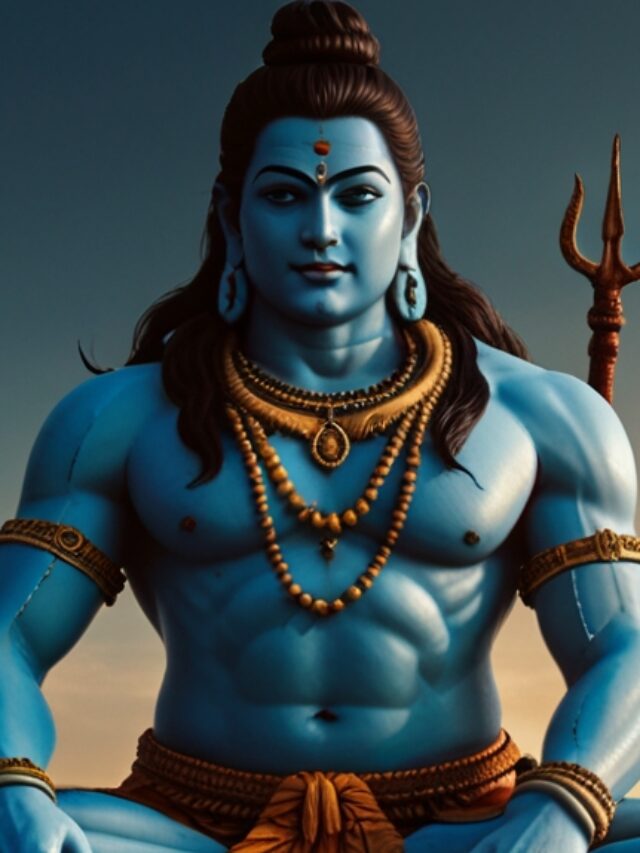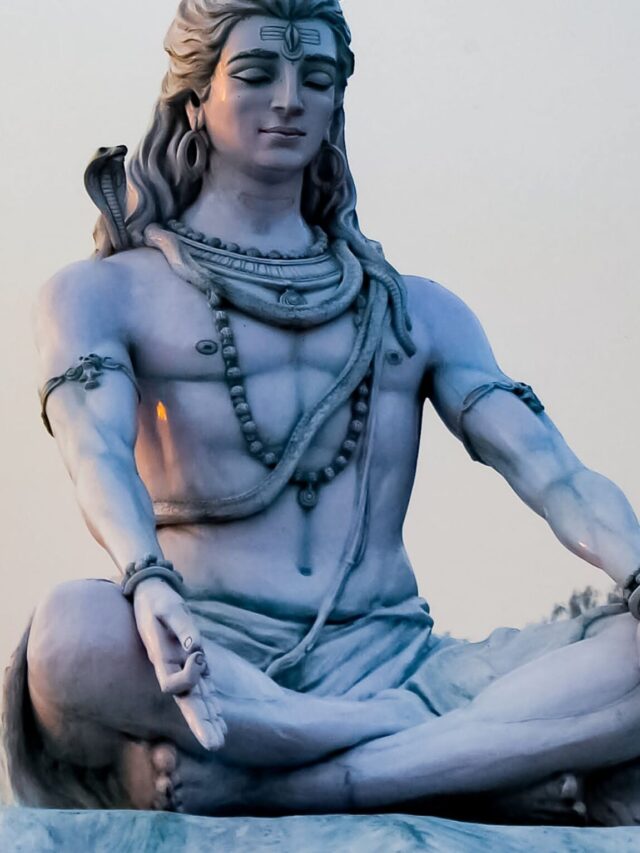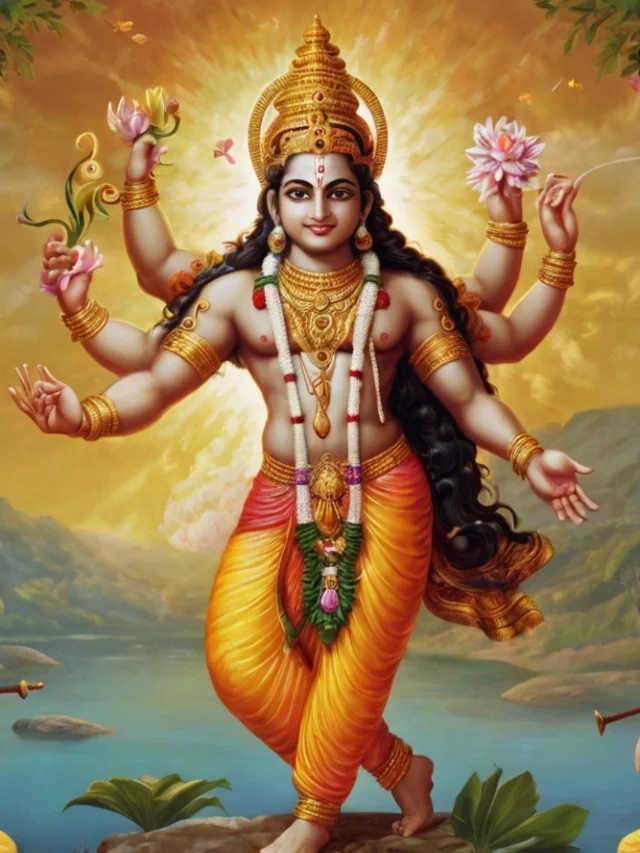Gathering Allies – Preparing for the Great War of Kurukshetra. Explore how the Pandavas and Kauravas gathered allies, strengthened their armies, and prepared with strategic weaponry and cavalry for the epic battle of Kurukshetra in the Mahabharata. Discover the story of Uttara and Abhimanyu’s marriage in the Mahabharata, a union that blended love and political alliance, and played a key role in shaping the events leading to the epic war of Kurukshetra.
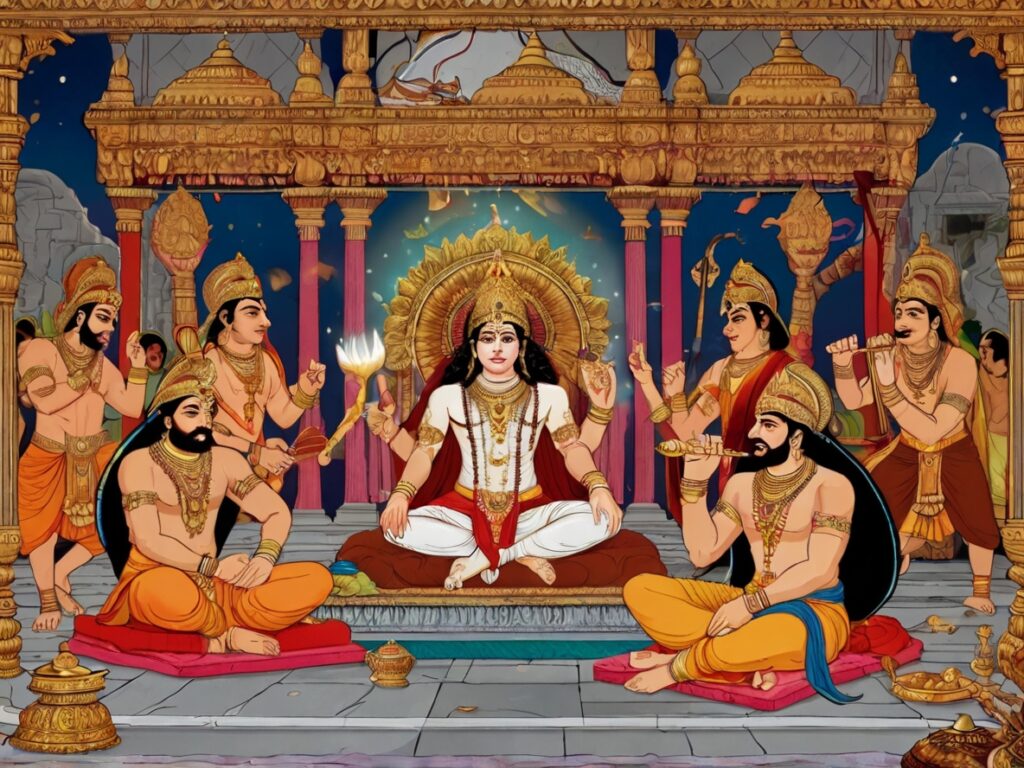
The marriage of Uttara and Abhimanyu
The marriage of Uttara and Abhimanyu is a significant event in the epic Mahabharata, reflecting both the political alliances of the time and the intertwining destinies of the characters.
Background of the Characters
- Abhimanyu is the son of Arjuna, one of the five Pandava brothers, and Subhadra, the sister of Lord Krishna. Abhimanyu is known for his valor, skill in warfare, and his knowledge of military strategies, despite his young age. He inherited many of his father’s qualities and was regarded as a great warrior, second only to the Pandavas themselves.
- Uttara is the daughter of King Virata, the ruler of Matsya Kingdom. Her father, Virata, was an ally of the Pandavas during their time of exile. Uttara was graceful, intelligent, and skilled in the arts, making her a fitting bride for a warrior prince like Abhimanyu.
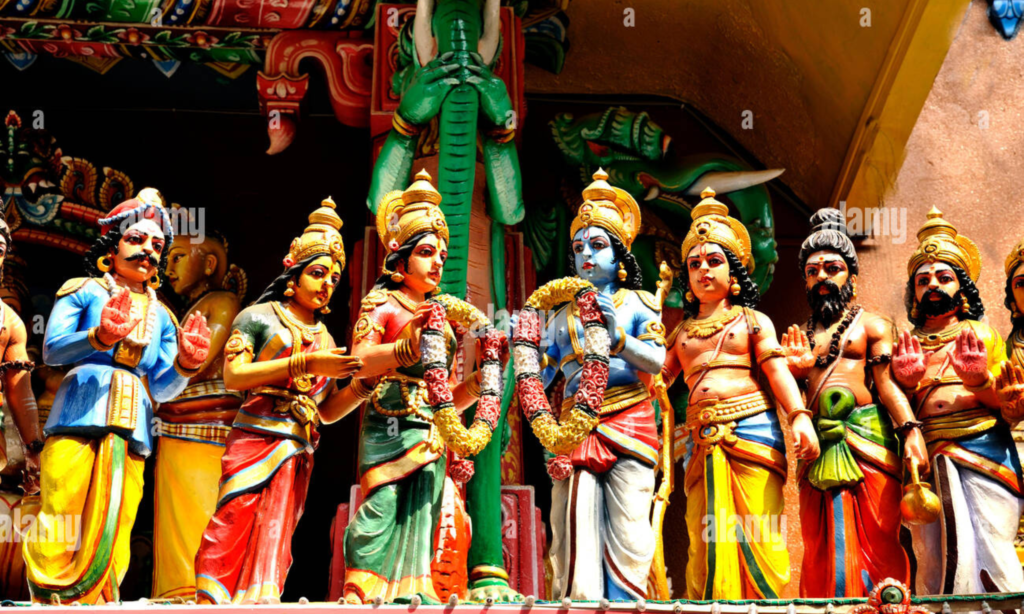
The Proposal and Marriage
The marriage between Uttara and Abhimanyu took place during the period of the Pandavas’ incognito exile. When the Pandavas were in their thirteenth year of exile, they lived incognito in the court of King Virata. Arjuna, who was disguised as Brihannala, a eunuch and a teacher of dance and music, taught Uttara these arts. During this time, Uttara formed a close bond with Arjuna, seeing him as a mentor and father figure.
When the period of exile was over, and the Pandavas revealed themselves, King Virata sought to strengthen his alliance with them by proposing the marriage of his daughter Uttara to Arjuna. However, Arjuna declined, citing that he considered Uttara to be like a daughter to him, as he had been her teacher. Instead, he suggested that Uttara marry his son Abhimanyu, who was a suitable match for her both in age and nobility.
The Grand Wedding
The marriage of Uttara and Abhimanyu was celebrated with great pomp and splendor in the court of King Virata. The wedding was attended by many prominent figures from the Mahabharata, including the Pandavas, Draupadi, Lord Krishna, and other kings and warriors of the time. The alliance was not only a union of two young hearts but also a political one, strengthening the bond between the Matsya Kingdom and the Pandavas in their struggle against the Kauravas.
Lord Krishna, who was Abhimanyu’s maternal uncle, played a key role in arranging the marriage and blessing the couple. The wedding was marked by joyous celebrations, rituals, and festivities, symbolizing hope and new beginnings even as the clouds of war loomed on the horizon.
Aftermath and the Tragic End
Though their marriage was brief, Uttara and Abhimanyu shared a deep bond. Unfortunately, their union was overshadowed by the impending war of Kurukshetra. Abhimanyu, with his courage and martial prowess, became a pivotal figure in the war. However, in a tragic turn of events, he was killed on the thirteenth day of the war while trapped inside the Chakravyuha (a complex military formation) devised by the Kauravas. His death was a significant and heart-wrenching loss for the Pandavas.
After Abhimanyu’s death, Uttara faced her greatest challenge. She was pregnant with their son, Parikshit. Following the war, when Ashwatthama, seeking revenge, released the Brahmastra to destroy the Pandava lineage, it targeted Uttara’s unborn child. However, Lord Krishna intervened, protecting the fetus and saving the future of the Pandava dynasty. Parikshit would later go on to become the king and the sole surviving heir of the Kuru dynasty.
Significance of Their Marriage
The marriage of Uttara and Abhimanyu symbolizes the union of love and duty, the hope for new beginnings amidst the hardships and turmoil of life, and the importance of alliances in the grand epic of the Mahabharata. Despite the tragic end of Abhimanyu, their union paved the way for the continuation of the Kuru dynasty through their son, Parikshit. Their story remains an integral part of the Mahabharata, illustrating the themes of sacrifice, love, and destiny.

Lord Krishna, volunteered to act as a messenger of peace and was sent to the court of Duryodhana
In the Mahabharata, before the great war of Kurukshetra took place, there was a final attempt to prevent bloodshed and bring about peace between the Pandavas and the Kauravas. Lord Krishna, who was a close friend, cousin, and guide to the Pandavas, volunteered to act as a messenger of peace and was sent to the court of Duryodhana, the eldest of the Kauravas, to negotiate a settlement and avoid the imminent war.
The Context Leading to Krishna’s Mission
After the Pandavas completed their thirteen years of exile — including one year of living incognito as stipulated by their agreement with the Kauravas — they requested the return of their rightful kingdom. Duryodhana, however, was adamant about not returning even a small part of the kingdom to the Pandavas. Despite several attempts at negotiation by various elders and well-wishers of both sides, Duryodhana refused to make peace.
As the conflict seemed inevitable, Lord Krishna decided to make one final effort to broker peace and avoid the catastrophic war. He agreed to go to Hastinapura, the capital of the Kuru kingdom, as an emissary of the Pandavas to negotiate with Duryodhana.
Krishna’s Arrival at Hastinapura
When Krishna arrived in Hastinapura, he was received with great honor by the Kuru elders like Bhishma, Drona, and Vidura. However, Duryodhana was skeptical and suspicious of Krishna’s intentions, believing that Krishna would favor the Pandavas, his cousins and friends.
Krishna’s first act was to meet with the respected elders of the Kuru court, including Bhishma, Drona, and Vidura, who all understood the impending disaster of war and supported Krishna’s peace mission. Krishna expressed his desire for peace and his hope that the elders could help persuade Duryodhana to reach a compromise with the Pandavas.
The Assembly in the Kuru Court
Krishna was invited to the royal court to present his proposal. He urged Duryodhana to avoid the war by returning Indraprastha and five villages to the Pandavas, where they could rule peacefully. Krishna’s words were both diplomatic and stern; he reminded Duryodhana of the kinship and duty between the Kauravas and Pandavas. He emphasized that war would result in the death of many noble warriors, and it would bring misery to countless families on both sides.
Krishna appealed to Duryodhana’s sense of dharma (righteousness), saying:
“O Duryodhana, you should not be driven by greed and hatred. Remember that the Pandavas are your brothers, and this war will only bring destruction. A wise king acts with justice and does not harm his own family. Even now, if you return just five villages, they will be satisfied and will not fight.”

Duryodhana’s Refusal and Attempt to Capture Krishna
Duryodhana, however, was obstinate and refused to give even “a needlepoint of land” to the Pandavas. He was driven by his desire to maintain power and his deep-seated animosity toward his cousins. Duryodhana, along with his advisors Karna, Shakuni, and Dushasana, mocked Krishna’s peace proposal and declared that war was the only solution.
Furthermore, blinded by arrogance and anger, Duryodhana hatched a plan to capture Krishna, believing that imprisoning him would demoralize the Pandavas and force them into submission. He ordered his guards to seize Krishna.
Krishna Reveals His Divine Form
Krishna, aware of Duryodhana’s intentions, laughed at his foolishness. At that moment, he chose to reveal his divine form, the Vishvarupa — a magnificent, multi-armed cosmic form that contained the entire universe within it. In this form, Krishna demonstrated his supreme power as the incarnation of the god Vishnu.
Everyone present in the court, including Bhishma, Drona, Dhritarashtra, and others, were awestruck and humbled by this divine vision. Dhritarashtra, who was blind, momentarily gained vision to witness Krishna’s divine form. Realizing the magnitude of Krishna’s power, the elders implored Duryodhana to accept Krishna’s peace offer and prevent the destruction of their dynasty. However, Duryodhana remained adamant, filled with pride and stubbornness, refusing to change his stance.
The Conclusion of Krishna’s Mission
After Duryodhana’s refusal, Krishna concluded that war was inevitable. He warned the Kauravas that they had chosen the path of destruction and that the consequences would be dire. Krishna then departed from Hastinapura, having fulfilled his duty as a messenger of peace.
On his way back, Krishna visited the Pandavas and informed them of Duryodhana’s refusal. The Pandavas, particularly Yudhishthira, were saddened but not surprised by Duryodhana’s decision. They prepared for the war, knowing that the path of peace had been exhausted.
Significance of Krishna’s Mission
Krishna’s mission as a messenger to Duryodhana is significant in several ways:
A Final Appeal for Peace: Krishna’s mission represented the final and sincere effort to avoid the devastating war of Kurukshetra. His diplomatic mission showcased the Pandavas’ willingness to settle for peace and compromise, emphasizing their adherence to dharma.
Revelation of Divinity: By revealing his divine form, Krishna demonstrated that his involvement in the conflict was not merely as a mortal but as an avatar of the divine, with a cosmic plan that went beyond human comprehension.
The Inevitable Fate: Krishna’s mission underscored the inevitability of fate and the consequences of one’s choices. Despite all efforts to prevent war, Duryodhana’s pride, greed, and hatred made the conflict unavoidable, leading to the destruction he had been warned about.
Dharma and Righteousness: The episode exemplifies the clash between dharma (righteousness) and adharma (unrighteousness). Krishna’s appeal was to uphold dharma, and Duryodhana’s refusal was a rejection of that principle, leading to the inevitable downfall of the Kauravas.
In essence, Krishna’s mission to Hastinapura is a pivotal moment in the Mahabharata, highlighting themes of duty, fate, and the moral complexities of war and peace.
Gathering of Allies and Strengthening of Armies
In the Mahabharata, the gathering of allies and strengthening of armies with necessary weaponry and cavalry played a crucial role in preparing for the great war of Kurukshetra. Both the Pandavas and the Kauravas understood that victory in the impending conflict would depend heavily on the strength of their allies, the size and skill of their armies, and the quality of their weaponry and military resources. This period of preparation saw strategic diplomacy, negotiations, and alliances forged across the Indian subcontinent.
The Pandavas’ Efforts to Gather Allies
After Krishna’s peace mission to Hastinapura failed and war became inevitable, the Pandavas began preparing for battle by reaching out to potential allies. They were aware that Duryodhana and the Kauravas had already amassed significant support, so they needed to build a coalition of their own to match the Kauravas’ strength.
1. Krishna’s Role in Securing Allies
Krishna, who was a close ally and well-wisher of the Pandavas, played a key role in securing allies for them. As the ruler of Dwarka and a revered figure throughout the land, Krishna had considerable influence among various kings and rulers. He personally approached many kings to seek their support for the Pandavas.
- The Offer to Krishna: Interestingly, both Duryodhana and Arjuna approached Krishna to seek his support in the war. Krishna, in turn, offered them a choice: one could have his mighty Narayani Sena (a formidable army of warriors from Dwarka), while the other could have Krishna himself as an ally, but he would not wield any weapons or fight in the war. Duryodhana, thinking the army would provide a greater advantage, chose the Narayani Sena, while Arjuna chose Krishna. Thus, Krishna became the charioteer and guide of Arjuna, offering his wisdom and support throughout the war.
2. Strategic Alliances through Marriage and Diplomacy
The Pandavas had already secured several important alliances through previous marriages and acts of diplomacy:
Matsya Kingdom: The marriage of Abhimanyu (Arjuna’s son) with Uttara, the daughter of King Virata of the Matsya Kingdom, secured the support of the Matsyas. King Virata was a staunch ally and provided a significant number of troops and resources.
Panchala Kingdom: The marriage of Draupadi to the five Pandavas had already secured the powerful Panchala kingdom. King Drupada, Draupadi’s father, was an influential ally with a strong army. Moreover, Drupada’s son, Dhrishtadyumna, was an excellent warrior who would later be appointed as the commander-in-chief of the Pandava army.
Other Allies: Through personal ties and acts of goodwill, the Pandavas gained the support of other important kings, including the rulers of Chedi, Kasi, Kekaya, and others.
3. Obtaining Divine Weapons
The Pandavas, particularly Arjuna, had previously acquired divine weapons during their years of exile. These weapons were bestowed upon them by various gods and celestial beings:
Arjuna’s Divine Weapons: During his exile, Arjuna performed severe penance and was blessed with many divine weapons, including those from Indra (his father), Shiva, Agni, and other gods. These weapons, such as the Pashupatastra from Lord Shiva, could unleash massive destruction and gave the Pandavas a significant edge in the war.
Bhima’s Strength and Weapons: Bhima, known for his immense physical strength, also received weapons from the wind god Vayu, his celestial father. His prowess with the mace was unmatched, making him a formidable force in battle.

The Kauravas’ Efforts to Gather Allies
Duryodhana, the leader of the Kauravas, was equally determined to strengthen his position by building a formidable coalition. He was the first to realize the necessity of gathering allies and had been working on securing support long before the war was declared.
1. Securing the Support of Key Kingdoms
Duryodhana had many loyal allies who were either bound to him by family ties, mutual interests, or previous favors:
Karna’s Friendship and Loyalty: Karna, the great warrior and son of Surya, was one of Duryodhana’s closest allies. Duryodhana had given Karna the kingdom of Anga, and in return, Karna vowed his unwavering loyalty to Duryodhana, even though he knew of his true birth as Kunti’s son. Karna’s presence in the Kaurava ranks was a major strategic advantage due to his formidable archery skills and knowledge of divine weapons.
The Kingdom of Madra: Duryodhana’s marriage alliance with Bhanumati, a princess of the Kalinga kingdom, and his close ties with Shalya, the king of Madra (and Nakula and Sahadeva’s maternal uncle), brought these powerful allies to his side. Although Shalya initially intended to support the Pandavas, Duryodhana cleverly won his allegiance by treating him with great honor on his way to the battlefield, securing his support for the Kauravas.
Bheeshma and Drona: The support of the legendary warriors Bhishma and Drona, who were bound by their duty to the Kuru throne, also gave the Kauravas a strategic advantage. Both warriors were highly respected and feared, and their presence greatly bolstered the morale of the Kaurava army.
The Kingdom of Gandhara and Others: Shakuni, Duryodhana’s maternal uncle and the prince of Gandhara, was a master strategist and played a pivotal role in securing many alliances for the Kauravas. Other allies included the kings of Kamboja, Sindhu, Pragjyotisha, and others, who joined the Kaurava ranks.
2. Assembling the Largest Army
With his vast resources and alliances, Duryodhana was able to amass a massive army. It is said that the Kaurava army consisted of 11 akshauhinis (military divisions), while the Pandava army had 7 akshauhinis. An akshauhini is a specific battle formation consisting of chariots, elephants, cavalry, and infantry.
Duryodhana also ensured that his army was well-equipped with the finest weaponry and war machinery. He gathered large numbers of elephants, horses, chariots, and skilled warriors to make his forces as strong and diverse as possible.
Preparation and Strengthening of Armies
Both sides engaged in extensive preparations to strengthen their armies and ensure they were ready for the battle:
Training and Strategy Sessions: The commanders of both armies — Bhishma, Drona, and Karna for the Kauravas, and Dhrishtadyumna, Arjuna, and Bhima for the Pandavas — held extensive training sessions and strategy meetings to prepare their soldiers for the complexities of war. They formulated strategies for different scenarios and trained their troops in various formations like Chakravyuha, Krauncha Vyuha, and others.
Acquisition of Weaponry and Armory: Both sides invested heavily in acquiring weapons, armory, and other war equipment. This included traditional weapons like swords, spears, bows, arrows, maces, and shields, as well as more advanced war machinery like chariots reinforced with armor, elephants, and cavalry. The quality and readiness of the equipment were carefully maintained to ensure maximum effectiveness in battle.
Securing Supplies and Logistics: Beyond just gathering troops and weaponry, both sides worked on ensuring a steady supply of food, water, medical supplies, and other logistics necessary for sustaining a prolonged war. Camps were established, and supply lines were secured to keep the armies fed, hydrated, and ready for battle.
The Importance of Gathering Allies and Military Preparation
The process of gathering allies and strengthening their armies was crucial for both the Pandavas and the Kauravas. It highlighted the importance of strategy, diplomacy, and preparation in warfare.
Diplomacy and Strategy: Both sides used diplomacy to forge alliances and bring powerful kingdoms under their banner. The strategic importance of these alliances went beyond just numbers; it also meant having access to unique skills, strategies, and knowledge that could turn the tide in battle.
Psychological Warfare: The gathering of allies and military preparations also served as psychological warfare. It demonstrated strength, commitment, and readiness to fight, which could either deter enemies or rally supporters.
Preparation for All Scenarios: Both sides prepared meticulously for various battle scenarios, understanding that the war would be long and challenging. The preparation of armies, weaponry, and strategy played a crucial role in how the war unfolded and ultimately shaped its outcome.
In the end, these efforts set the stage for the great battle of Kurukshetra, a conflict that would decide the fate of the Kuru dynasty and change the course of history in the Mahabharata.

